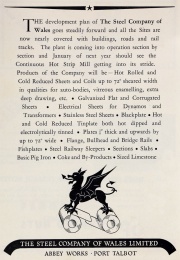Steel Company of Wales
































The Steel Company of Wales was formed in 1947 as a public company by British (Guest Keen, Baldwins) Iron and Steel Co, Richard Thomas and Baldwins, Lysaght Works and Llanelli Associated Tinplate to modernise the South Wales sheet and tinplate industry.
1947 Planned to build two tinplate works in the Swansea and Llanelli districts to meet demand and soak up some of the labour made redundant at the old style works. Started clearing the site at Velindre (Swansea) in 1947 but work was put on hold and the site at Trostre (Llanelli) was developed as it was felt that the need for work was greater in the Llanelli area than in north Swansea.
1947 Officially took over the running of Port Talbot/Margam.
1951 The company, including Lysaght Works, were nationalised under the Iron and Steel Act; became part of the Iron and Steel Corporation of Great Britain[1]
1951 Trostre came into production and work on the Velindre site recommenced.
1956 The Velindre works were commissioned when each of the three works operated two modern continuous tinning lines.
1956 Joint sales arrangements, and research and development, with Richard Thomas and Baldwins discontinued[2].
1957 Public sale of shares in the company by Holding and Realization Agency; application for shares by GKN and Metal Box Co met in full; about 85% of the issue was left with the underwriters[3].
1960 Advert shows the Cold Strip Mill, built for the Velindre Works by Davy-United.
1961 Main works at Abbey Works, Port Talbot and branch works at Margam (Port Talbot), Trostre (Llanelly), Velindre (Swansea) and Orb Works (Newport). Employ 25,000 persons.
In 1967 the Steel Company of Wales were taken over by British Steel and with further developments each works operated with four electrolytic continuous tinning lines, producing one point two million tons of tinplate per annum.
At its peak Velindre works employed more than 2,000 and it was considered to be the 'jewel in the crown' in British Steel, having the reputation for higher yields with fewer complaints than the other two works.
1980 Following increased worldwide competition it was decided in December 1980 that one of the three tinplate works would have to close and Velindre was elected.
1981 A total of 1,300 people were made redundant in March 1981, though 138 were found jobs at Trostre. This left just 768 on the Velindre site.
1989 Production was gradually run down until the works finally ceased production in 1989. Another 108 were given jobs at Trostre, and a small workforce were kept on for a short period to clear the site
See Also
- 1950 Institution of Mechanical Engineers: Visits to Works
- 1955 Table of 50 Largest Employers
- 1958 Institution of Mechanical Engineers: Visits to Works
- 1961 List of Largest Employers
- 1962 Health and Safety Exemptions
- 1968 Who's Who in the Motor Industry: Companies
- 1971 Who's Who in the Motor Industry: Companies
- British (Guest Keen, Baldwins) Iron and Steel Co
- British Steel
- British Steel: 1986 Constituent Companies
- Cashmore, Sparrow (Steel Sheets)
- Charles Bruce-Gardner
- Davy-United
- Elba Tin Plate Co
- Engineering 1951 Jul-Dec: Index: General
- Engineering 1952 Jan-Jun: Index: General
- Engineering 1952 Jan-Jun: Index: Plates
- Engineering 1952 Jul-Dec: Index: Plates
- Engineering 1953 Jan-Jun: Index: General
- Engineering 1956 Jan-Jun: Index
- Engineering 1956 Jul-Dec: Index
- Foden
- Gorseinon Tinplate Works
- Henry Francis Spencer
- Iron and Steel Corporation of Great Britain
- John Lysaght
- Marshfield Iron Works
- Melingriffith Co
- Port Talbot Steel Co
- Richard Thomas and Baldwins
- Steel Co of Wales
- The Engineer 1947 Jan-Jun: Index
- The Engineer 1947 Jul-Dec: Index
- The Engineer 1948 Jul-Dec: Index
- The Engineer 1951 Jan-Jun: Index
- The Engineer 1951 Jul-Dec: Index
- The Engineer 1953 Jan-Jun: Index
- The Engineer 1953 Jul-Dec: Index
- William Frederick Cartwright
Sources of Information
- [1] BBC Web Site
- 1961 Guide to Key British Enterprises

